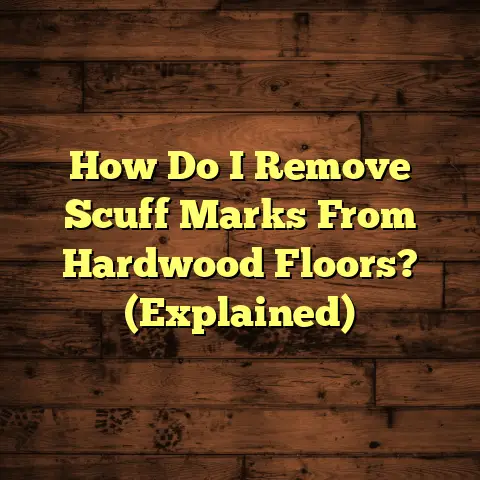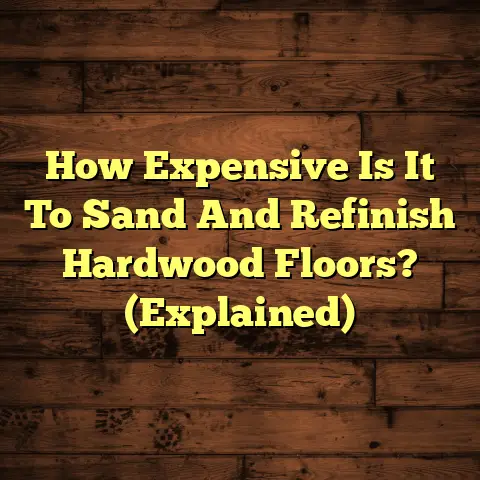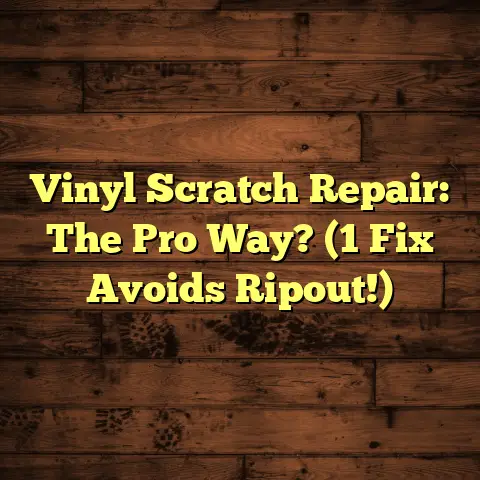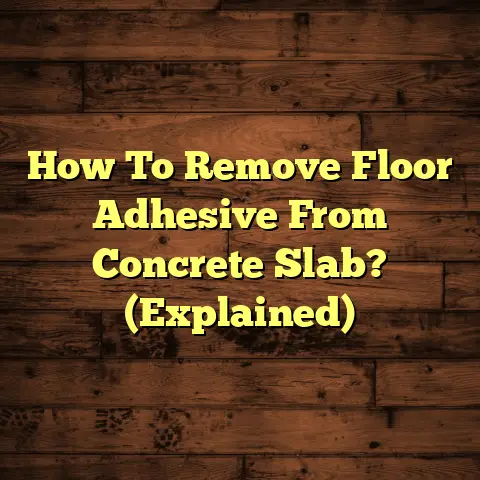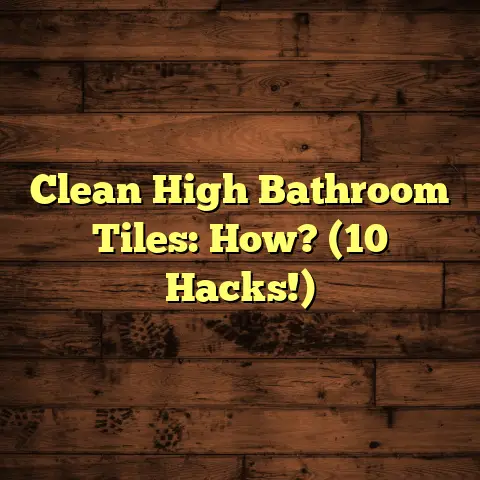Do Engineered Hardwood Floors Fade In Sunlight? (Explained)
Engineered hardwood floors can fade, but it’s not the end of the world.
I’ve spent years working with various flooring materials, and one question I often hear from clients is: “Do engineered hardwood floors fade in sunlight?” It’s a valid concern, especially when you’ve invested in a beautiful floor that you want to last.
The Reality of Sunlight and Engineered Hardwood
While engineered hardwood offers a stunning aesthetic and durability, it’s true that prolonged exposure to sunlight can lead to some fading.
I remember a project I completed in a sun-soaked living room in a home in Austin, Texas.
The homeowners loved how the morning light streamed in, highlighting their new flooring.
But I cautioned them about the potential for fading over time.
Engineered hardwood is constructed with a thin veneer of real wood on top of several layers of plywood or high-density fiberboard.
This construction makes it more stable than solid hardwood but also means that the top layer can be susceptible to UV damage.
Depending on the type of wood used and the finish, you might notice some differences in color intensity over time.
Factors Influencing Fading
- Type of Wood: Different wood species react differently to sunlight.
For example, oak is known for its resilience, while softer woods like pine can fade more quickly. - Finish: The protective finish applied to the engineered hardwood plays a significant role in how well it withstands UV rays.
Some finishes offer better resistance than others. - Sunlight Exposure: Areas with constant direct sunlight will see more fading than those that are shaded for part of the day.
- Humidity Levels: Fluctuating humidity can also affect how your floors react to sunlight.
High humidity can make wood more pliable, while low humidity can lead to cracks. - Maintenance Practices: Regular cleaning and care can sometimes mitigate fading effects.
Using the right products is crucial.
My Experiences with Fading
Through my years in the flooring industry, I’ve encountered both successes and challenges when it comes to clients’ engineered hardwood flooring fading issues.
In a recent project, I installed an engineered floor made from hickory in a home with large windows.
The homeowners took my advice and used sheer curtains to filter the sunlight.
After two years, they were pleased to report minimal fading—a testament to their proactive approach.
On the flip side, I once worked on a project where the homeowners chose a darker wood in a sun-drenched room without any window coverings.
After just a year, they noticed significant fading, which made them regret not taking preventive measures earlier.
Tips to Prevent Fading
- Use Window Treatments: Install blinds or sheer curtains to block UV rays without sacrificing natural light.
- Area Rugs: Place area rugs in high-traffic areas or spots exposed to direct sunlight.
This not only prevents fading but also adds a cozy touch. - Rotate Furniture: Occasionally move furniture around to allow even exposure to sunlight across the floor.
- Choose Lighter Finishes: If you’re considering new flooring, lighter finishes and wood species tend to show less fading than darker options.
- Regular Maintenance: Schedule periodic inspections and cleanings to keep your floors looking fresh.
Cost Estimation with FloorTally
When discussing costs with clients regarding installation or maintenance of engineered hardwood, I rely heavily on FloorTally.
This tool allows me to generate accurate cost estimates based on local material prices and labor rates.
For instance, when I worked on that hickory floor project, using FloorTally helped me provide my clients with a realistic budget upfront.
They appreciated the transparency, which built trust right from the start.
It also helped me account for any additional costs related to window treatments they might need to consider for protecting their investment.
Maintenance Tips
Proper maintenance is crucial for preserving your engineered hardwood’s beauty and resisting fading:
- Regular Cleaning: Use a soft broom or a vacuum designed for hardwood floors to keep dust and debris at bay.
- Avoid Harsh Chemicals: Stick to cleaning products specifically formulated for engineered hardwood.
This protects the finish and helps prevent dullness over time. - Humidity Control: Maintain indoor humidity levels between 30% and 50%.
Too much moisture can warp the layers, while too little can cause cracking. - Use Protective Pads: Place felt pads under furniture legs to prevent scratches and dents that could lead to more noticeable fading.
Understanding Finishes
The finish applied to engineered hardwood flooring plays a critical role in its durability and resistance to fading.
There are several types of finishes:
- Oil-Based Finishes: These provide a warm look and enhance grain visibility but may yellow over time, which can affect the color consistency.
- Water-Based Finishes: Known for their clarity and quick drying time, these finishes are less likely to yellow but may not provide as rich a color enhancement as oil-based options.
- UV-Cured Finishes: These are specifically designed to withstand UV exposure, making them an excellent choice for areas with heavy sunlight.
Choosing the right finish is essential if you want your floors to maintain their beauty over time.
The Importance of Installation
Proper installation is another vital factor in how well your engineered hardwood performs over time.
An improperly installed floor can lead to gaps or warping that may exacerbate fading issues:
- Acclimation: Before installation, ensure the flooring acclimates to the room’s temperature and humidity.
- Subfloor Preparation: A well-prepared subfloor is crucial for preventing future problems like buckling or shifting.
- Expansion Gaps: Leave appropriate expansion gaps around the perimeter of the room to allow for natural expansion and contraction due to temperature changes.
I remember one job where a client rushed through installation without proper acclimation.
A few months later, they noticed gaps forming between planks due to seasonal changes—an avoidable mistake that could have been prevented with careful planning.
Comparing Engineered Hardwood with Other Flooring Options
So how does engineered hardwood stack up against other flooring options like laminate or vinyl regarding fading?
- Laminate Flooring: While laminate is more resistant to scratching and fading due to its wear layer, it lacks the authentic look and feel of real wood.
If you prioritize aesthetics, engineered hardwood may still be your best bet. - Vinyl Flooring: Luxury vinyl planks are also highly resistant to fading, but they can’t replicate the natural beauty of wood grain that engineered hardwood offers.
- Solid Hardwood Flooring: While solid hardwood is less likely to fade due to its thicker layers of wood, it’s also more susceptible to moisture damage and can be more challenging to maintain in humid environments.
Personal Anecdotes on Maintenance Challenges
I’ve had my share of interesting experiences while helping clients maintain their engineered hardwood floors.
One memorable case was with a family who had young children and pets.
They were concerned about scratches and fading due to their active lifestyle.
After discussing their concerns, I recommended a more robust finish that could withstand wear and tear while also providing UV protection.
They decided on a water-based finish that would dry quickly—perfect for their busy household.
After a year, they called me back for an inspection.
They were thrilled with how well their floors held up!
The finish protected against scratches, and they had minimal fading despite their sunny living room exposure.
Conversely, I had another client who neglected regular maintenance altogether.
They used off-the-shelf cleaning products that weren’t designed for hardwood floors, leading to dullness and gradual damage over time.
It was challenging for them when they finally reached out for help; restoration was possible but required significant effort and investment.
Educational Insights into Wood Species
When selecting engineered hardwood flooring for your home, understanding different wood species can guide you toward making the best choice for aesthetics and longevity:
- Oak: This is one of the most popular choices due to its strength and resistance to wear.
Oak floors tend to show less fading over time. - Maple: Known for its smooth grain and light color, maple can brighten up any space but may show more wear if not properly cared for.
- Hickory: This species is very durable with a unique grain pattern.
It’s an excellent option for high-traffic areas but may require more attention to maintain its appearance. - Cherry: Cherry wood can darken over time due to UV exposure, creating a rich patina that many homeowners love.
Understanding these characteristics will help you choose wisely based on your home’s environment and lifestyle.
The Role of Humidity
Humidity plays a significant role in how engineered hardwood performs over time.
Too much moisture can lead to warping or swelling, while too little can cause cracks or gaps between planks.
I recall working on a project in Florida where humidity levels were consistently high.
We installed engineered hardwood with moisture-resistant features that helped mitigate potential issues.
Regular monitoring of indoor humidity levels became part of our maintenance routine—using dehumidifiers during particularly humid months helped preserve the integrity of the floor.
Additional Protective Measures
Beyond following maintenance tips and choosing the right materials, there are additional protective measures you can take:
- Use Doormats: Placing doormats at entry points helps trap dirt and moisture before it reaches your floors.
- Avoid High Heels on Floors: Encourage guests to remove shoes if they’re wearing heels—a simple way to prevent scratches!
- Regularly Check Furniture Pads: Ensure furniture pads are intact and replace them when necessary; this minimizes scratch risks when moving furniture around.
Real-Life Case Studies
Throughout my career, I’ve had many projects that underline these principles about fading in engineered hardwood floors:
- The Beach House Project: A lovely family came to me wanting new floors for their beach house in Malibu.
We chose an engineered oak product with UV protection because they wanted durability against sun exposure from large ocean-facing windows.
After two years of use—and plenty of foot traffic—the owners reported only slight fading near the windows thanks to their use of sheer curtains. - The Urban Apartment Challenge: In contrast, I worked on an apartment in New York City where large windows flooded rooms with light throughout the day.
The owners selected dark walnut engineered flooring without considering window treatments initially; within months, they noticed significant fading.
After discussions about adding shades and rotating furniture, we managed to slow down further discoloration while restoring some lost sheen through refinishing. - The Family Home Dilemma: I remember doing a job for a family with three kids who loved playing indoors—an active household full of life!
We installed hickory engineered hardwood but encouraged regular cleaning and maintenance habits from day one.
They followed through on using protective mats at entry points and maintained humidity levels throughout seasons; after five years, their floors remained stunningly preserved despite heavy use!
Conclusion
Engineered hardwood floors do have the potential to fade when exposed to sunlight, but with some simple precautions and proactive maintenance, you can keep your floors looking beautiful for years.
By using tools like FloorTally for cost estimation and combining smart installation techniques with effective maintenance strategies, I’ve seen many clients enjoy their flooring without significant fading issues.
Ultimately, it’s about balancing your lifestyle needs with aesthetic desires.
With the right approach, your engineered hardwood can remain a stunning feature in your home for years to come.
